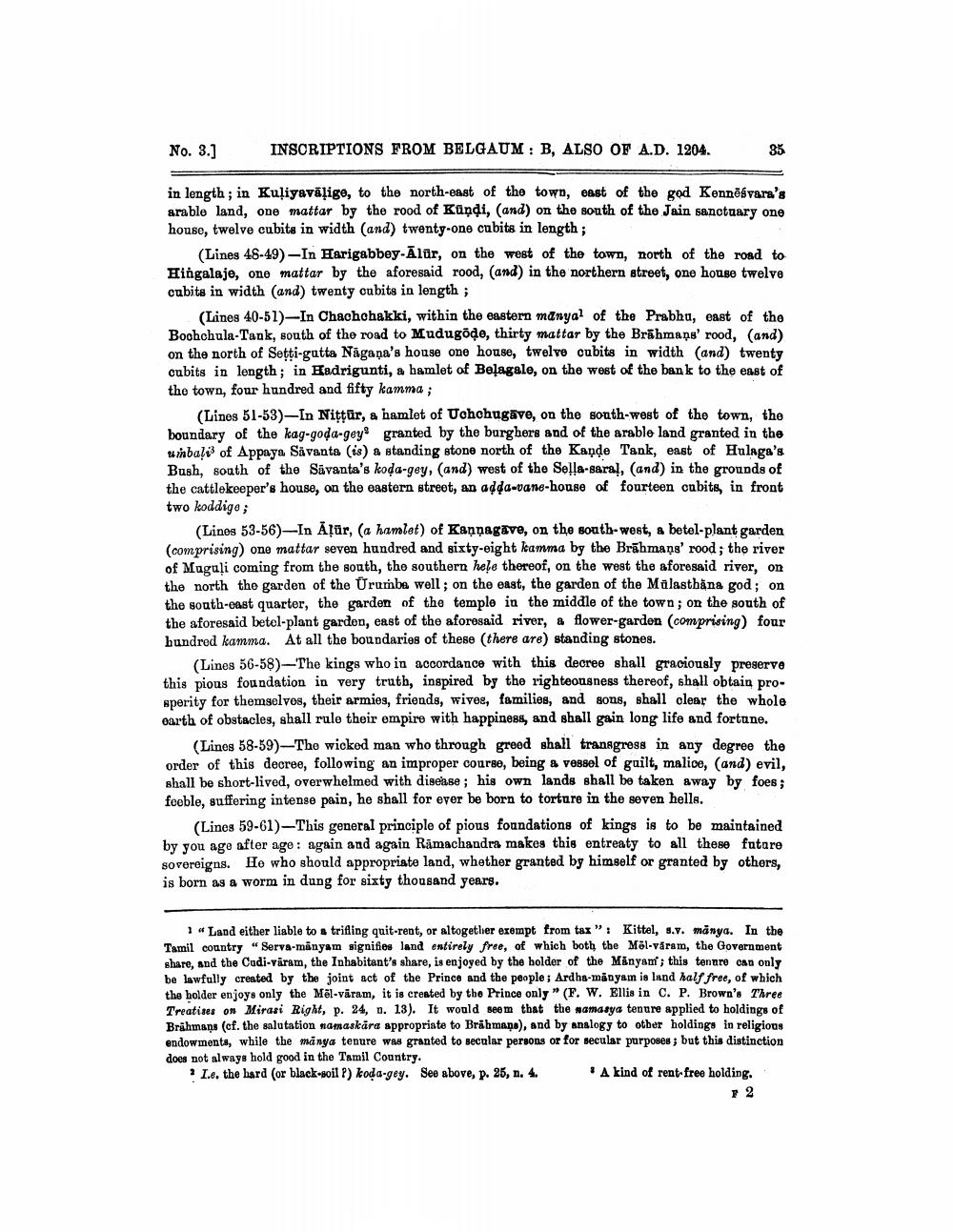________________
No. 3.]
INSCRIPTIONS FROM BELGAUM : B, ALSO OF A.D. 1204.
35
in length: in Kuliyavālige, to the north-east of the town, east of the god Kennēsvara's arable land, one mattar by the rood of Kundi, (and) on the south of the Jain sanctuary one houso, twelve cubita in width (and) twenty-one cubits in length;
(Lines 48-49)-In Harigabbey-Alür, on the west of the town, north of the road to Hingalaje, one mattar by the aforesaid rood, (and) in the northern street, one house twelve cubits in width (and) twenty cubits in length;
(Lines 40-51)-In Chachchakki, within the eastern manyal of the Prabhu, east of the Boshchula-Tank, south of the road to Mudugode, thirty mattar by the Brāhmaṇs' rood, (and) on the north of Setti-gutta Nägaņa's house one house, twelve cubits in width (and) twenty cubits in length; in Badrigunti, a bamlet of Belagale, on the west of the bank to the east of the town, four hundred and fifty kamma;
(Lines 51-53)-In Nittūr, s hamlet of Uchchugāve, on the south-west of the town, the boundary of the kag-goda-gey granted by the burghers and of the arable land granted in the umbali of Appaya Såvanta (is) a standing stone north of the Kande Tank, east of Hulaga's Bush, south of the Savanta's koda-gey, (and) west of the Sella-sara!, (and) in the grounds of the cattlekeeper's house, on the eastern street, an adda-vane-house of fourteen cubits, in front two koddige;
(Lines 53-56)-In Aļūr, (a hamlet) of Kannagāve, on the south-west, a betel-plant garden (comprising) one mattar seven hundred and sixty-eight kamma by the Brāhmans' rood; the river of Maguli coming from the south, the southern hele thereof, on the west the aforesaid river, on the north the garden of the Urumba well; on the east, the garden of the Malasthåna god; on the south-east quarter, the garden of the temple in the middle of the town; on the south of the aforesaid betol-plant garden, east of the aforesaid river, a flower-garden (comprising) four hundred kamma. At all the boundaries of these there are) standing stones.
(Lines 56-58)-The kings who in accordance with this decree shall graciously preserve this pious foundation in very truth, inspired by the righteousness thereof, shall obtain prosperity for themselvos, their armies, friends, wives, families, and sons, shall clear the whole earth of obstacles, shall rule their empire with happiness, and shall gain long life and fortune.
(Lines 58-59)—The wicked man who through greed shall transgress in any degree the order of this decree, following an improper course, being a vessel of guilt, malice, (and) evil, shall be short-lived, overwhelmed with disease ; his own lands shall be taken away by foes; feeble, suffering intense pain, he shall for ever be born to torture in the seven helle.
(Lines 59-61)-This general principle of pious foundations of kings is to be maintained by you age after age: again and again Ramachandra makes this entreaty to all these futare sovereigns. He who should appropriate land, whether granted by himself or granted by others, is born as a worm in dung for sixty thousand years.
1 " Land either liable to a trifling quit-rent, or altogether exempt from tax"; Kittel, s.v. mānya. In the Tamil country "Serva-manyam signifios land entirely free, of which both the Mol-varam, the Government share, and the Cudi-vāram, the Inhabitant's share, is enjoyed by the holder of the Mänyam; this tenure can only be lawfully created by the joint act of the Prince and the people ; Ardhs-manyam is land half free, of which the holder enjoys only the Mel-vāram, it is created by the Prince only " (F. W. Ellis in C. P. Brown's Three Treatises on Mirasi Right, p. 24, n. 13). It would seem that the namasya tenure applied to holdings of Brahmans (cf. the salutation namaskāra appropriate to Brāhmaṇa), and by analogy to other holdings in religious endowments, while the manya tenure was granted to secular persons or for secular purposes; but this distinction does not always hold good in the Tamil Country. ? I.e. the hard (or black-soil P) koda-gey. See above, p. 25, n. 4.
A kind of rent-free holding.
F 2




